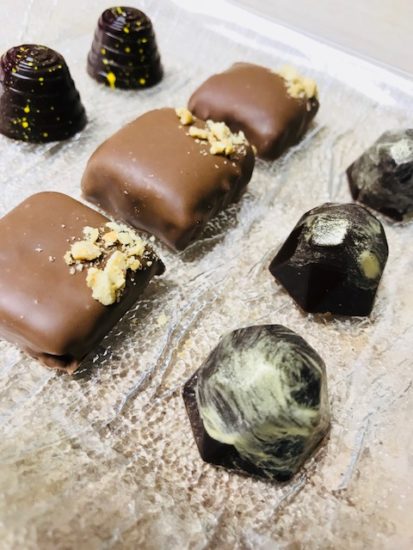Cody Middleton, Pastry Chef of Forsyth CC, believes the modern praline turns heads by exhibiting a strategically-designed color scheme and sophisticated fillings.
In February, chocolate is in the spotlight. And as the pastry chef of Forsyth Country Club, this craze prompted me to initiate a new confectionary program here at the club.

From left to right: Passion Fruit Madagascar Vanilla Bean (the spiral praline with yellow spots), Milk Chocolate Peanut Butter Feuilletine, and Sea Salt Caramel Milk Chocolate (the “geode” praline brushed with gold luster).
For Valentine’s Day, I introduced an array of different chocolate pralines (otherwise known as bonbons). The word “praline” can have a few different meanings. It can refer to a brown sugar and pecan treat particularly popular in the southern US, a combination of nuts (generally almonds and/or hazelnuts) caramelized with sugar that is usually ground and used as a flavoring base, or a small chocolate confection. To avoid any confusion, I will be using the latter characterization of “praline.”
Chocolate pralines can be divided into subcategories depending on how they are made. Pralines may be molded, cut (peanut or mocha squares), or piped/scooped (classic truffles). The most mesmerizing and show-stopping pralines are typically molded. The shine that comes from polishing truly makes this style of pralines pop. There is also an endless number of ways to design each praline. In school, I was taught the very basics of molded pralines: a dark chocolate shell with a ganache-based filling. While mastering the basics is fundamental, there are a million different ways to craft a praline. I used to prefer this style because of its unadulterated and standard appearance. Now, however, I prefer the use of colors and an array of fillings which add contrast and excitement to a monotonous presentation.
In my opinion, a praline should be treated much like any other plated dessert. Its appearance should be tempting and compelling with a filling that provides depth and complexity. The colors, if used, should be an indication of the filling. Standards should be established so that each filling is deposited into a specific mold with a distinguishing color pattern. I also believe that there should be some restraints with the filling by not having too many flavors that they are too muddled to shine as a whole. For example, a simple passion fruit filling can be elevated by infusing a vanilla bean into the cream. The floral notes of the vanilla don’t overpower or compete with the passion fruit. It merely provides a lighter contrast. Fillings can be personalized for specific holidays as well. A spiced rum and egg-milk ganache or peppermint ganache would be perfect for Christmas. Meanwhile, a pumpkin spice or maple cream would be appropriate for Halloween or Thanksgiving.
The modern praline should also offer the guest some sort of surprise. Different crunch layers or multiple fillings may naturally be utilized to create a more interesting praline. Having two-toned layers within the filling also simple way to offer a more interesting praline.
Salted Caramel Praline Inside
The type of couverture used to make the shell of each praline should also be harmonious with the filling. Generally speaking, a semi-sweet couverture is used with a strong flavored filling like a salted caramel. On the other hand, a milk or white couverture is paired with mild flavored fillings such as a honey Earl Grey ganache. With this said, I make the “white wine should be paired with seafood” analogy when discussing these pairings. These are not set rules, but general guidelines that can absolutely change based on the chef’s or member’s preferences. Furthermore, I was taught and practice the 90:10 rule when making pralines. That is, a perfect praline should be composed of 90% filling and 10% shell. Since the shell is the most expensive part of the praline, the thinnest shell should be achieved in order to maintain expenses and eating qualities. I can personally say, one of the worst experiences is biting into a shell that is too thick.
While some members may prefer the classic, traditional pralines that were modest and one toned with a lackluster filling, the modern praline turns heads by exhibiting a strategically-designed color scheme and sophisticated fillings. Like with many items, pralines are a vehicle for club pastry chefs to showcase our creativity. With pralines, however, our talents are encapsulated inside an irresistible, recognizable, and delectable piece of art.




